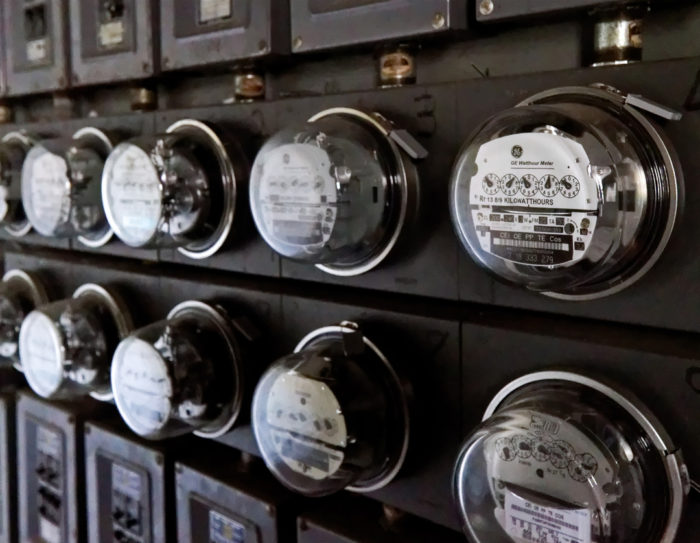
Image Credit: Mark Turnauckas / Flickr
We’ve found that many electric utilities have contradictory policies in place. It’s like driving with the brakes on.
Many large utilities operate programs to help building owners improve the energy performance of their buildings, such as by paying a portion of the cost to install high-efficiency air conditioners or heat-pump water heaters. This is one foot on the gas pedal. These programs make sense because building owners are prime movers in the vital utility mission to improve the energy performance of our nation’s building stock, and efficiency programs deliver great value back to the utility’s customers.
Here’s the simultaneous braking: Many of the same utilities do not give owners basic information about how much energy is used in their buildings.
This problem occurs in thousands of buildings occupied by multiple tenants with their own utility accounts, such as apartments, shopping malls, and offices. The building owner needs to know the total kilowatt hours of electricity used in the building to assess energy improvement projects. Giving the owner a “whole-building” total means the owner does not have to read meters manually or collect paper bills from tenants — time-consuming, error-prone, and unnecessary.
Yet many building owners in many cities cannot obtain this basic information from their utility, even if only on a monthly basis, and even if new “smart meters” are in place.
The good news
Several leading utilities have adopted sensible solutions, such as Commonwealth Edison in Chicago, PEPCO in Washington, D.C., Eversource in Boston, National Grid in New York, and Consolidated Edison in New York. Some have created online “portals” for building owners to obtain summary information (such as Landlord Manager from DTE Energy or PEPCO’s system). These utilities implemented solutions because it is good for their customers. Here’s how:
California catches up
California utilities, at long last, can be crossed-off the list of utilities with self-defeating policies in place. Recent legislation solves the problem. AB 802 (expected to be signed by the governor this week) amends the law to make clear California utilities must deliver total monthly usage information to building owners even if the total is composed of multiple utility customers in the building.
The legislation was jointly led by the California Energy Commission and NRDC. The legislative fix could not have happened without the leadership of Commissioner Andrew McAllister, active support of Gov. Jerry Brown, and advocacy from many allies, including California mayors (especially from the City of San Francisco), building owners (many thanks to BOMA California), efficiency experts, housing developers, consumer groups, to name a few.
The news for other utilities is that legislation is not needed. Utilities can and should implement sensible policies now to give owners the information needed to understand the energy performance of their buildings. Any utility (or utility regulator) that intends to encourage better energy performance in its buildings should be sure it is not “hitting the brakes” by making this information difficult to obtain.
Why would a utility not share information?
Clichés abound on the importance of good information to making decisions, such as a building owner’s decision to invest in efficiency improvements. “You can’t manage what you don’t measure.” “Garbage in, garbage out.” “Good information is the lifeblood of markets.” Cliché or not, these phrases reflect a truth backed by common sense.
It is difficult to know exactly why a utility would not deliver whole-building information to building owners. We now have several years’ experience with policies in place at leading utilities, and these utilities report the policies have worked.
Some have argued utilities should not provide whole-building usage information because the information could reveal something about an individual tenant’s usage. But this risk can be fully addressed with reasonable, narrowly tailored protections. In situations where this risk is realistic — buildings with one or two tenants — a utility could require a building owner to obtain the tenants’ permission (such as in the lease agreement) to receive whole-building information. Another option is for the utility to deliver a notice to the included tenants that the owner will receive a whole-building total, thereby allowing tenants with specialized concerns (such as a manufacturer) to negotiate protective measures with the landlord.
A reality check: Any building owner interested in a tenant’s energy use could already get it by simply looking at the readable meter display to see how much energy is used! Delivering the information to the owner adds data integrity, speed, and brings the parties into the information age.
Utilities in California arguably already had the authority to deliver whole-building usage information to building owners. In 2011, the California Public Utilities Commission correctly held that usage information aggregated of multiple customers is not protected “customer information,” so long as the total does not reasonably convey a particular customer’s usage. (CPUC Decision 11-07-056, see page 151). This is consistent with commonly used privacy standards for publishing aggregated information. But California utilities argued other regulations created ambiguity. Legislation helped break the logjam.
Any utility or utility regulator intending to encourage better energy performance in buildings should assure owners can obtain whole-building usage information. This will allow programs and incentives that push toward better energy performance to work as they should.
Enabling greater energy efficiency is not only good for customers in the affected buildings, but it’s good for all the utility’s customers by lowering the utility’s costs. And, greater building efficiency means we don’t need to generate as much electricity, avoiding the pollution associated with using fossil fuels to make it. This is good for the nation and the world.
Philip Henderson is a senior financial policy specialist with the Natural Resource Defense Council in Washington, D.C. This post was originally published at the NRDC’s Switchboard.
Weekly Newsletter
Get building science and energy efficiency advice, plus special offers, in your inbox.















0 Comments
Log in or create an account to post a comment.
Sign up Log in